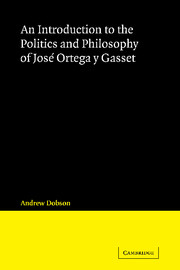Book contents
7 - What is philosophy and why is it done?
Published online by Cambridge University Press: 05 March 2012
Summary
In February 1929, Ortega began teaching a course at the University of Madrid entitled ¿Quées filososfía? (What is Philosophy?). The course constituted the first complete approximation to his mature philosophy, and it has been suggested – I think correctly – that the catalyst for Ortega's beginning to put his house in order was the appearance in 1927 of Heidegger's Sein und Zeit (Being and Time). Ortega was surprised and disconcerted to find that Heidegger's book contained ideas similar to those he had been entertaining at least since 1914 in the Meditaciones del Quijote, and an allusion to Heidegger in the course of 1929 makes it clear that the German philosopher was a central point of reference: ‘To live is to find oneself in the world … in a very recent and brilliant book Heidegger has made us take note of the enormous significance of those words’ (OC 7, 416). Further: ‘I am pleased to recognise that the person who has made most progress in the analysis of life is the new German philosopher Martin Heidegger’ (ibid.). From 1929 onwards it was Ortega's intention to respond to Heidegger's publication of Sein und Zeit, and ¿Qué es filosofía? constitutes his first attempt to formalise ideas which had been gestating for so long.
He begins by asking, ‘Why does it occur to man – today, tomorrow or whenever – to philosophise?’ (OC 7, 307), and, ‘What I would like to do is to take the very activity of philosophy – philosophising itself – and submit it to a radical analysis’ (OC 7, 279).
- Type
- Chapter
- Information
- Publisher: Cambridge University PressPrint publication year: 1989



